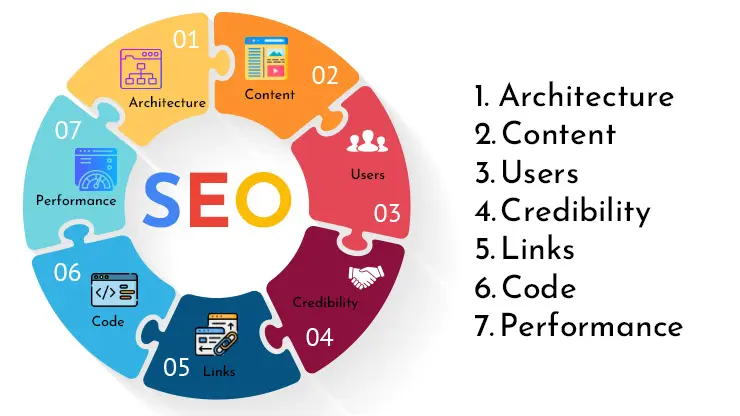In the ever-evolving world of search engine optimization (SEO), staying ahead of the curve means understanding the fundamental elements that contribute to a successful strategy. These elements can be categorized into seven critical groups: Content, Architecture, Code, Credibility, Links, User, and Performance. Each plays a unique role in how search engines evaluate and rank your website. Let’s dive deep into these groups and explore strategies that SEO experts can employ to maximize their site’s relevance and visibility.
Content: The King of SEO
Content is often hailed as the king in SEO, and for good reason. High-quality, relevant content is what drives user engagement and allows algorithms to understand and rank your site effectively.
- Prioritize Value: Focus on creating content that provides real value to your readers. Answer questions, solve problems, and engage users with fresh, compelling topics.
- Keyword Research: Use keyword research tools to uncover the phrases and questions your target audience is searching for, and naturally incorporate these into your content.
- Diverse Content Types: Incorporate a mix of content types (blogs, videos, infographics) to cater to different user preferences and increase engagement.
Architecture: Building a Solid Foundation
The architecture of your website plays a crucial role in how search engines crawl and index your pages.
- Intuitive Navigation: Ensure your site structure is logical and user-friendly. Users and search engines alike should be able to navigate your site effortlessly.
- Mobile-Friendly Design: With mobile-first indexing, prioritize a responsive design that looks and performs great across all devices.
- SSL Certificate: Secure your site with HTTPS to protect user data and improve your site’s trustworthiness in the eyes of search engines.
Code: The Backbone of Your Site
Optimizing the underlying code of your website can significantly impact your SEO performance.
- Clean and Efficient Code: Simplify your site’s code to improve loading times and make it easier for search engines to crawl your site.
- Structured Data: Implement structured data (schema markup) to help search engines understand and display your content in search results more effectively.
- Meta Tags: Accurately use meta tags (title tags, meta descriptions) to improve your content’s click-through rate from search engine results pages (SERPs).
Credibility: Establishing Trust
Search engines favor websites that demonstrate authority, expertise, and trustworthiness on a topic.
- Secure Backlinks: Earn backlinks from reputable sites in your industry to boost your site’s credibility.
- Social Proof: Leverage customer reviews, testimonials, and social media mentions to enhance your brand’s trust and visibility.
- Regular Updates: Consistently update your site with fresh content and ensure all information is current and accurate.
Links: The Pathways of the Internet
Internal and external links play a pivotal role in SEO, guiding both users and search engines throughout your site and the broader internet.
- Internal Linking: Use internal links to connect related content across your site, improving navigation and distributing page authority.
- Quality Backlinks: Focus on acquiring high-quality backlinks rather than a high quantity of low-quality links. Quality always trumps quantity.
- Anchor Text: Use descriptive anchor text for both internal and external links to give users and search engines context about the linked content.
User: Prioritizing the Human Element
At the end of the day, SEO is about serving real people. User experience (UX) factors heavily into SEO rankings.
- Load Time: Optimize your site’s loading time to reduce bounce rates and improve user satisfaction.
- Engaging Design: Use an appealing visual design that encourages users to stay longer and engage more deeply with your content.
- User Intent: Understand and meet user intent by providing the most relevant and valuable content for their search queries.
Performance: The Need for Speed
A website’s performance is closely tied to its success in search engine rankings.
- Speed Optimization: Use tools like Google PageSpeed Insights to identify and fix issues slowing down your site.
- Browser Caching: Implement browser caching to reduce load times for repeat visitors.
- Minify Resources: Minify CSS, JavaScript, and HTML to reduce file sizes and improve page load times.
- There are many SEO benefits of a fast-loading website
By focusing on these seven critical groups—Content, Architecture, Code, Credibility, Links, User, and Performance—SEO experts can create a robust strategy that enhances both search engine visibility and user experience. Remember, SEO is a continuous process of testing, learning, and optimizing. Stay updated on the latest trends and algorithm updates, and always keep your audience’s needs at the forefront of your strategy.










